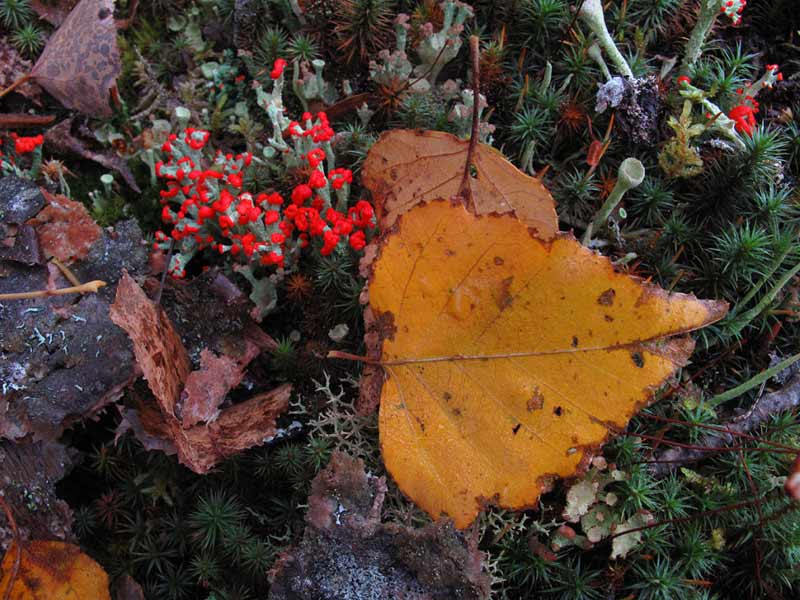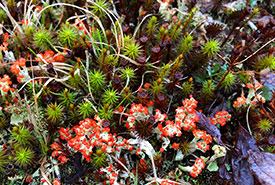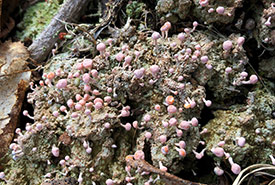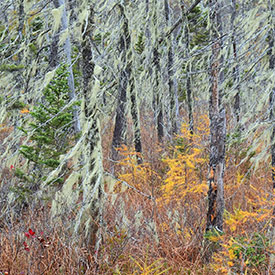Lichens: An often overlooked little universe

The colours, forms and textures of the microcosms are fascinating. (Photo by Doug van Hemessen/NCC staff)
I often go out for an “aimless wander,” especially in the woods surrounding my home.
Aimless wandering is a way of being mindful through wandering and spaciousness versus concentration and focus.
It is as the words themselves: aimless and wandering. It is an opportunity to leave your preoccupied mind and open your awareness to the surrounding environment. Seeing, listening, smelling, touching, even tasting if something edible is on hand. No destination, no plan, no formal hike. This is the foundation of “forest bathing.” It is letting go of time and entering a mindset of discovery and appreciation.
It is in such a mindset that I discover details; the small, the overlooked. I’m thrilled by the tiny pockets of “the universe” that I find. Often this means lichens and mosses. Things you need to stop and really look at to appreciate. Intricacies appear. It takes time to observe. To really look, to really see.
Lichens are all around but often unnoticed. They can be found worldwide, from ocean coasts to mountain peaks, from the Arctic to Antarctica.

Lichens are like tiny pockets of the universe. You need to really look to appreciate them. (Photo by Doug van Hemessen/NCC staff)
They grow on almost any surface in many diverse (and sometimes weird) forms. Rocks, soil and other plants are all homes for lichens. In areas freshly denuded of vegetation, they are typically the first organisms to gain a foothold. Lichens are the foundation of development of more complex ecosystems.
They can withstand extremes of temperature and drought. However, many are sensitive to air pollutants. Their absence can be an indication of poor air quality.
Lichens are not parasitic; they make their own nutrients. They are a great example of symbiosis: two distinct entities, fungus and algae (or cyanobacteria), combining to form a unique organism. The fungus gathers moisture and nutrients from the environment and protects the algae, which in turn gets energy from the sun and provides carbohydrates. They are a unified pair.

Fairy puke (Photo by Doug van Hemessen/NCC staff)
Depending on where you are they may be both discreet and obvious. Some are showy, others require a magnifying glass to observe. (A magnifying glass or loupe will reveal an amazing world of details.)
If you are observant, you will have no problem finding a lichen.
In my home province of Nova Scotia, there are hundreds of species of lichens. Even those unfamiliar with lichens have seen them.

Old man's beard (Photo by Doug van Hemessen/NCC staff)
“Old man’s beard” is a common name for a type of lichen that hangs as short, tangled, light green strings from tree branches. The common name reference is obvious. “British soldiers” is another, with its scarlet reproductive fruiting bodies reminiscent of the “red coats” of ye olden years. Another common and easily seen lichen is lungwort, a green, leafy species on tree trunks that can grow quite large and, when wet, spectacularly green. Fairy puke anyone? These are the clusters of pink dots often seen on disturbed soil, such as road shoulders.
Despite their ubiquitous and generally hardy nature, some lichens are designated as species at risk. Boreal felt lichen and vole’s ears lichen are endangered. Their decline is linked to prevailing winds that bring pollution from central Canada to the eastern U.S., which lands in Nova Scotia as acid rain. Pollution isn’t the only threat; boreal felt lichen is threatened by logging and is also sensitive to climate change.
Time spent in nature is time well spent. Get yourself out there. Pause.
Close your eyes. Listen. Smell.
Feel. Breathe. Let go of the thinking that preoccupies you. Open your eyes. Can you find a lichen?


